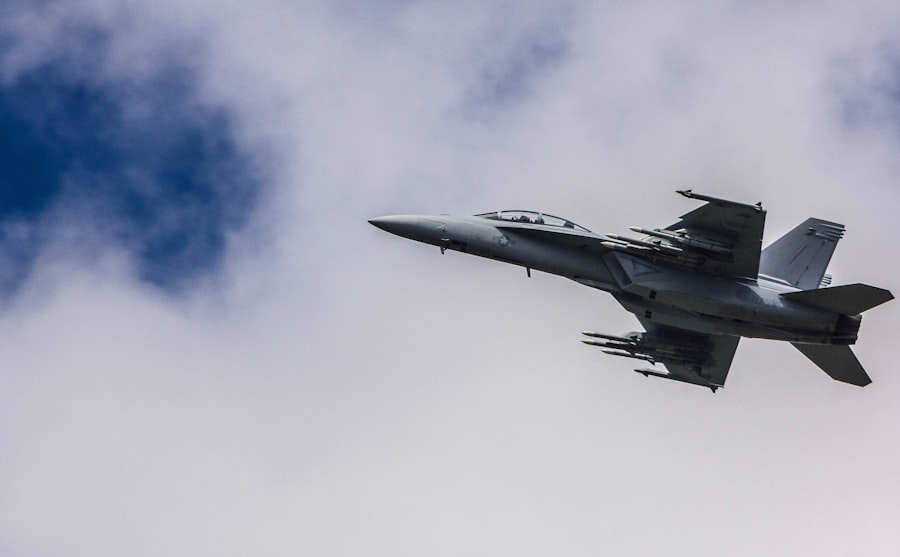The F-14 Tomcat, a name synonymous with naval aviation prowess, stands as one of the most iconic fighter jets in history. Developed by Grumman Aircraft Engineering Corporation, the F-14 was designed to serve as a carrier-based air superiority fighter for the United States Navy. Its distinctive variable-sweep wing design not only contributed to its striking appearance but also enhanced its versatility in various flight regimes.
The F-14’s operational capabilities, combined with its advanced avionics and weapon systems, made it a formidable adversary in the skies, capable of engaging multiple threats simultaneously. The F-14’s legacy is not merely a product of its technical specifications; it is also deeply intertwined with its role in popular culture, particularly through its portrayal in films such as “Top Gun.” This cinematic representation helped cement the F-14’s status as a symbol of American military might during the Cold War era. As we delve into the history, development, and operational capabilities of the F-14, it becomes evident that this aircraft is not just a machine of war but a testament to the evolution of military aviation technology.
Key Takeaways
- The F-14 Fighter Jet was a supersonic, twin-engine, two-seat aircraft designed for air superiority and fleet defense missions.
- The F-14 was developed by Grumman Aerospace Corporation and first flew in 1970, entering service with the U.S. Navy in 1974.
- Key features of the F-14 included variable-sweep wings, advanced avionics, and the ability to carry a wide range of air-to-air and air-to-ground weapons.
- In combat, the F-14 was known for its speed, agility, and long-range missile capabilities, making it a formidable force in both air-to-air and air-to-ground missions.
- Pilots and crew members required extensive training and skills to operate the F-14, including aerial combat tactics, navigation, and weapon systems management.
History and Development of the F-14
The genesis of the F-14 can be traced back to the late 1960s when the U.S. Navy recognized the need for a new air superiority fighter to replace the aging F-4 Phantom
The Navy sought an aircraft that could engage enemy aircraft at long ranges while also possessing the agility to perform dogfighting maneuvers. In response to this requirement, Grumman began developing the F-14 under the Tactical Fighter Experimental (TFX) program. The design process was marked by innovative engineering solutions, particularly the introduction of variable-sweep wings, which allowed the aircraft to optimize its aerodynamic performance across a wide range of speeds.

The first flight of the F-14 occurred on December 21, 1970, and it quickly demonstrated its capabilities during testing. The aircraft’s design featured twin engines, a sophisticated radar system, and an array of air-to-air missiles, including the AIM-54 Phoenix, AIM-7 Sparrow, and AIM-9 Sidewinder. These features positioned the F-14 as a multi-role fighter capable of engaging both high-speed targets at long distances and maneuverable threats in close combat.
By 1974, the F-14 entered service with the U.S. Navy, marking a significant milestone in naval aviation history.
Key Features and Capabilities of the F-14
| Key Features and Capabilities of the F-14 | |
|---|---|
| Manufacturer | Grumman Aerospace Corporation |
| Role | Interceptor, air superiority fighter |
| Max Speed | 1,544 mph (2,485 km/h) |
| Range | 1,600 mi (2,574 km) |
| Weapons | Phoenix, Sparrow, and Sidewinder missiles |
| Engines | 2 × Pratt & Whitney TF30 turbofans |
| Crew | 2 (pilot and radar intercept officer) |
One of the most defining characteristics of the F-14 is its variable-sweep wing design, which allows pilots to adjust the wing’s angle during flight. This feature enhances performance by providing optimal lift and drag characteristics at various speeds. For instance, when flying at high speeds, the wings can be swept back to reduce drag and improve stability.
Conversely, during slower speeds or takeoff and landing phases, the wings can be extended to increase lift. This adaptability makes the F-14 exceptionally versatile for carrier operations. In addition to its aerodynamic design, the F-14 is equipped with advanced avionics that significantly enhance its combat capabilities.
The AN/AWG-9 radar system is one of its standout features, capable of tracking multiple targets simultaneously and providing targeting information for long-range engagements. Coupled with the AIM-54 Phoenix missile system, which boasts an impressive range of over 100 miles, the F-14 can engage enemy aircraft before they even enter combat range. Furthermore, its ability to carry a diverse array of weapons—including precision-guided munitions—enables it to perform ground attack missions alongside its primary air superiority role.
Unleashing the Power of the F-14 in Combat
The F-14’s combat debut came during Operation Desert Storm in 1991, where it showcased its capabilities in a real-world conflict. Deployed from aircraft carriers in the Persian Gulf, F-14s played a crucial role in establishing air superiority over Iraq. The aircraft’s long-range engagement capabilities allowed it to intercept and destroy enemy aircraft before they could pose a threat to coalition forces.
Notably, F-14s achieved several aerial victories during this conflict, demonstrating their effectiveness in combat scenarios. Beyond Desert Storm, the F-14 has been involved in various military operations around the globe. Its versatility has allowed it to adapt to different mission profiles, from air-to-air combat to ground support missions.
The aircraft’s ability to operate from aircraft carriers also means it can project power far from U.S. shores, making it an essential asset for naval operations. The F-14’s performance in combat has solidified its reputation as one of the premier fighter jets of its time.
Training and Skills Required to Operate the F-14

Operating an F-14 requires extensive training and a unique skill set due to the aircraft’s complexity and advanced systems. Pilots undergo rigorous training programs that encompass both theoretical knowledge and practical flight experience. Initial training typically begins with basic flight training on simpler aircraft before progressing to more advanced platforms.
Once selected for F-14 training, pilots must master various aspects of flying this sophisticated fighter jet. The training process includes simulator sessions that replicate various flight scenarios, allowing pilots to practice emergency procedures and combat tactics without leaving the ground. Additionally, pilots must become proficient in using the aircraft’s avionics systems, including radar operation and weapon targeting.
The ability to make quick decisions under pressure is crucial; thus, training emphasizes situational awareness and tactical decision-making skills. Furthermore, crew coordination between pilots and radar intercept officers (RIOs) is essential for maximizing the F-14’s capabilities during missions.
Maintenance and Upkeep of the F-14
Maintaining an aircraft as complex as the F-14 requires meticulous attention to detail and a well-trained maintenance crew. The aircraft’s systems are intricate and demand regular inspections and repairs to ensure operational readiness. Maintenance personnel are responsible for everything from routine checks to major overhauls, ensuring that each aircraft remains in peak condition for flight operations.
The maintenance process involves several key areas: airframe inspections, engine maintenance, avionics checks, and weapon system readiness assessments. Each component must be carefully monitored for wear and tear, as even minor issues can lead to significant operational challenges during flight. Additionally, maintenance crews must stay updated on technical manuals and service bulletins issued by manufacturers to address any emerging issues or improvements in procedures.
Legacy of the F-14 in Military Aviation
The legacy of the F-14 extends beyond its impressive technical specifications and combat achievements; it has left an indelible mark on military aviation history. As one of the first fighters designed specifically for carrier operations with advanced capabilities, it set a precedent for future naval aircraft development. The lessons learned from operating the F-14 have influenced subsequent designs and operational strategies within naval aviation.
Moreover, the F-14 has become a cultural icon, representing not only military strength but also technological innovation. Its appearances in popular media have contributed to its legendary status among aviation enthusiasts and the general public alike. The aircraft’s unique design and capabilities have inspired generations of engineers and pilots who aspire to push the boundaries of what is possible in military aviation.
Future of the F-14 and its Impact on Modern Warfare
While the F-14 was officially retired from U.S. Navy service in 2006, its impact on modern warfare continues to resonate today. The lessons learned from operating this aircraft have informed current fighter jet designs and strategies employed by air forces around the world.
The emphasis on multi-role capabilities and advanced avionics seen in contemporary fighters can be traced back to innovations pioneered by the F-14. Additionally, some nations continue to operate modified versions of the F-14, showcasing its enduring relevance in military aviation. Countries like Iran have maintained their fleets through upgrades and modifications, demonstrating that even older platforms can remain effective with proper maintenance and modernization efforts.
As military conflicts evolve with advancements in technology and tactics, the foundational principles established by aircraft like the F-14 will undoubtedly influence future developments in aerial warfare strategies. In conclusion, while the F-14 Tomcat may no longer be an active component of U.S. naval aviation, its legacy endures through its contributions to air combat tactics, engineering innovation, and cultural significance within military history.
The lessons learned from its operational history continue to shape modern aerial warfare strategies and inspire future generations of aviators and engineers alike.


